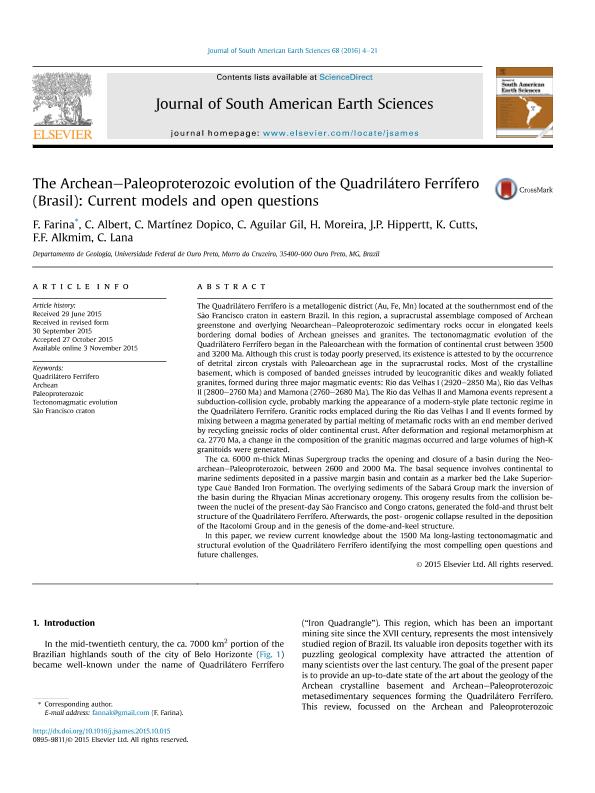Mostrar el registro sencillo del ítem
dc.contributor.author
Farina, F.
dc.contributor.author
Capucine, A.
dc.contributor.author
Martínez Dopico, Carmen Irene

dc.contributor.author
Aguilar Gil, C.
dc.contributor.author
Moreira, H.
dc.contributor.author
Hippertt, J. P.
dc.contributor.author
Cutts, K.
dc.contributor.author
Alkmim, F.
dc.contributor.author
Lana, C.
dc.date.available
2017-06-16T21:37:28Z
dc.date.issued
2016-07
dc.identifier.citation
Farina, F.; Capucine, A.; Martínez Dopico, Carmen Irene; Aguilar Gil, C.; Moreira, H.; et al.; The Archean–Paleoproterozoic evolution of the Quadrilátero Ferrífero (Brasil): Current models and open questions; Elsevier; Journal Of South American Earth Sciences; 68; 7-2016; 4-21
dc.identifier.issn
0895-9811
dc.identifier.uri
http://hdl.handle.net/11336/18377
dc.description.abstract
The Quadrilátero Ferrífero is a metallogenic district (Au, Fe, Mn) located at the southernmost end of the São Francisco craton in eastern Brazil. In this region, a supracrustal assemblage composed of Archean greenstone and overlying Neoarchean–Paleoproterozoic sedimentary rocks occur in elongated keels bordering domal bodies of Archean gneisses and granites. The tectonomagmatic evolution of the Quadrilàtero Ferrífero began in the Paleoarchean with the formation of continental crust between 3500 and 3200 Ma. Although this crust is today poorly preserved, its existence is attested to by the occurrence of detrital zircon crystals with Paleoarchean age in the supracrustal rocks. Most of the crystalline basement, which is composed of banded gneisses intruded by leucogranitic dikes and weakly foliated granites, formed during three major magmatic events: Rio das Velhas I (2920–2850 Ma), Rio das Velhas II (2800–2760 Ma) and Mamona (2760–2680 Ma). The Rio das Velhas II and Mamona events represent a subduction-collision cycle, probably marking the appearance of a modern-style plate tectonic regime in the Quadrilátero Ferrífero. Granitic rocks emplaced during the Rio das Velhas I and II events formed by mixing between a magma generated by partial melting of metamafic rocks with an end member derived by recycling gneissic rocks of older continental crust. After deformation and regional metamorphism at ca. 2770 Ma, a change in the composition of the granitic magmas occurred and large volumes of high-K granitoids were generated. The ca. 6000 m-thick Minas Supergroup tracks the opening and closure of a basin during the Neoarchean–Paleoproterozoic, between 2600 and 2000 Ma. The basal sequence involves continental to marine sediments deposited in a passive margin basin and contain as a marker bed the Lake Superior-type Cauê Banded Iron Formation. The overlying sediments of the Sabará Group mark the inversion of the basin during the Rhyacian Minas accretionary orogeny. This orogeny results from the collision between the nuclei of the present-day São Francisco and Congo cratons, generated the fold-and thrust belt structure of the Quadrilátero Ferrífero. Afterwards, the post- orogenic collapse resulted in the deposition of the Itacolomi Group and in the genesis of the dome-and-keel structure. In this paper, we review current knowledge about the 1500 Ma long-lasting tectonomagmatic and structural evolution of the Quadrilátero Ferrífero identifying the most compelling open questions and future challenges.
dc.format
application/pdf
dc.language.iso
eng
dc.publisher
Elsevier

dc.rights
info:eu-repo/semantics/openAccess
dc.rights.uri
https://creativecommons.org/licenses/by-nc-sa/2.5/ar/
dc.subject
Quadrilatero Ferrífero
dc.subject
Sao Francisco Craton
dc.subject
Archean
dc.subject
Paleoproterozoic
dc.subject
Tectonomagmatic Evolution
dc.subject.classification
Geoquímica y Geofísica

dc.subject.classification
Ciencias de la Tierra y relacionadas con el Medio Ambiente

dc.subject.classification
CIENCIAS NATURALES Y EXACTAS

dc.title
The Archean–Paleoproterozoic evolution of the Quadrilátero Ferrífero (Brasil): Current models and open questions
dc.type
info:eu-repo/semantics/article
dc.type
info:ar-repo/semantics/artículo
dc.type
info:eu-repo/semantics/publishedVersion
dc.date.updated
2017-06-16T15:21:58Z
dc.journal.volume
68
dc.journal.pagination
4-21
dc.journal.pais
Países Bajos

dc.journal.ciudad
Amsterdam
dc.description.fil
Fil: Farina, F.. Universidade Federal de Ouro Preto; Brasil
dc.description.fil
Fil: Capucine, A.. Universidade Federal de Ouro Preto; Brasil
dc.description.fil
Fil: Martínez Dopico, Carmen Irene. Universidade Federal de Ouro Preto; Brasil. Consejo Nacional de Investigaciones Científicas y Técnicas; Argentina
dc.description.fil
Fil: Aguilar Gil, C.. Universidade Federal de Ouro Preto; Brasil
dc.description.fil
Fil: Moreira, H.. Universidade Federal de Ouro Preto; Brasil
dc.description.fil
Fil: Hippertt, J. P.. Universidade Federal de Ouro Preto; Brasil
dc.description.fil
Fil: Cutts, K.. Universidade Federal de Ouro Preto; Brasil
dc.description.fil
Fil: Alkmim, F.. Universidade Federal de Ouro Preto; Brasil
dc.description.fil
Fil: Lana, C.. Universidade Federal de Ouro Preto; Brasil
dc.journal.title
Journal Of South American Earth Sciences

dc.relation.alternativeid
info:eu-repo/semantics/altIdentifier/doi/http://dx.doi.org/10.1016/j.jsames.2015.10.015
dc.relation.alternativeid
info:eu-repo/semantics/altIdentifier/url/http://www.sciencedirect.com/science/article/pii/S0895981115300808?via%3Dihub
Archivos asociados
